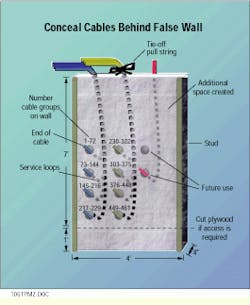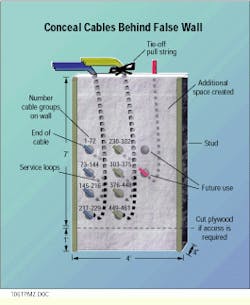False wall improves cable installation in the telecommunications closet
Dennis Mazaris,
PerfectSite
Problem
Your terminating hardware blocks are mounted to the wall. The cables feeding into the blocks from the ceiling above look like a rat`s nest. Other cables have been installed on top of the cable maze, making it look even worse. In some places, cables are spliced and hidden behind other cables because they were terminated in the wrong location and had to be rerouted.
Solution
Construct a false wall that provides ample space to conceal horizontal and backbone cables. Not only will this improve the appearance of the telecommunications closet field layout, but it can also decrease cable-dressing time. It will give you flexibility to terminate cables if they`re not in the correct order, and it will simplify future moves, adds and changes.
Procedure
This procedure is recommended for the telecommunications closet. For the main equipment room, you may want to use materials that provide a more attractive finish. The basic concept, however, remains the same.
1) Purchase fire-resistant plywood. Your general contractor may be able to provide a small-quantity purchase. Construction grade plywood will cost approximately $40 per sheet, and for plywood (AC grade) that is smooth on one side, calculate approximately $50 per sheet. Both types measure 8 ft x 4 ft x 0.75 inch. You will also need wood studs (two by fours), which will cost approximately $6 each. (Metal studs may be used as an alternative.)
2) Attach the studs to the telecommunications closet wall. Ensure that the studs do not interfere with access to terminating block holes, as cables may need to be routed to other blocks.
3) Affix the plywood sheet (or sheets) to the studs with nails or screws, allowing a minimum of 3 to 4 inches of clearance -- depending on stud size -- behind the false wall. You will also need to leave space for additional cable slack as a service loop.
4) If access from the bottom of the false wall is required, make sure to cut the plywood and studs before constructing the wall.
5) Drill holes in the plywood where cables are to be brought into terminating blocks -- the larger the holes, the better, as long as the terminating blocks cover the holes. Add additional holes to allow for expansion.
6) Feed a pull string from the top of the plywood to all the holes. Tie off string at an appropriate point above or below the false wall.
7) Sort all cables in numerical order. Align cable over the holes from which they will emerge.
8) Attach cables to the pull string.
9) Lower or raise cables behind the false wall, and feed cables into the holes nearest the points where they are to be terminated. You may find it easier when lowering the cables to work consistently from left to right, and bottom to top.
10) Leave adequate service loops to extend cables to other blocks in case the numbering on the cable is incorrect.
Concealing cables behind a false wall can be accomplished more easily by sorting in groups before dropping them behind the wall. Always work from left to right and from bottom to top.
Dennis Mazaris is a consultant at PerfectSite, Sterling, VA, and a Bicsi registered communications distribution designer (Rcdd).

